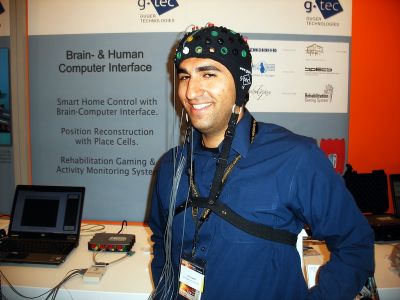TOBI
received EUR 9 million in EU research funding to develop practical
technology for brain-computer interaction to improve the quality of life
of people like 20-year-old Francesco and 53-year-old Jean-Luc.
Jean-Luc Geiser suffered a stroke which left him completely paralysed and unable to speak.
Thanks to TOBI, Jean-Luc was able to communicate by typing email
messages via a computer cursor controlled through his brain waves.
‘Participating in this project allowed me to see that I can still be
useful to society’ he said in a statement read by his sister at the
project’s final workshop.
‘There are many people suffering from different levels of physical
disability who cannot control their body but whose cognitive level is
sufficiently high,’ said project coordinator José del R. Millán , a professor at the Ecole Polytechnique Fédérale de Lausanne . ‘We want them to be part of our society.’
In contrast to similar experiments which usually involved
able-bodied patients or invasive brain implants, TOBI broke new ground
by developing non-invasive prototypes. By using inexpensive and readily
available equipment, the project could also achieve a great deal in a
relatively short time.
BRAIN POWER IN PRACTICE
TOBI involved at least three kinds of brain-to-computer dialogue which meant paralysed patients could communicate and even move.
The first involved sending brain signals to a computer cursor via
electrodes attached to a cap worn on the head. Simply by thinking about
what they wanted to type, patients could remotely control the computer
cursor to surf the web and write emails and texts.
In the second experiment, patients sent brain signals to control a
small robot with video, audio and obstacle-detection sensors. They could
then use the robot to take a ‘virtual’ walk around the hospital or even
hook up with loved ones in different places.
Other patients were able to regain control of their paralysed limbs
just by thinking about moving them. This was done using computer
software designed to detect a patient’s intention to perform a certain
motor function. In some cases, intensive training and rehabilitation
helped them to keep that control even after the electronics were
removed.
Throughout the project, researchers relied on patient feedback to
fine-tune the technology they were working with. The users became part
of the research team.
‘There was no black magic,’ said Professor Millán. ‘We listened to
the feedback of all the patients to correct design mistakes and made any
changes right away. We also took into consideration the feedback of
professional end users who worked with the patients in hospital.’ Many
patients also got a sense of satisfaction from feeling part of something
important, even those unable to continue past the first initial
experiments.
A RAY OF HOPE
The project ended last year and the systems are still being tested
and further developed. Some of the equipment is being used at clinics
and hospitals which are TOBI partners .
Health-care professionals have also run many of the
brain-to-computer interactions independently or with little remote
assistance from researchers and tests have been carried out in homes,
outside the well-controlled laboratory conditions.
‘Altogether, this is proof of the degree of robustness and
possibilities of today’s brain-computer interaction (BCI) technology,’
said Professor Millán. ‘Hopefully our research will encourage further
work in this field to improve the lives of disabled patients with
healthy, functioning brains.’
Link to project's website
Link to related video
 EN
EN  CS
CS DE
DE ES
ES FR
FR HU
HU IT
IT PL
PL PT
PT РУ
РУ SK
SK TR
TR УК
УК AR
AR 中文
中文







